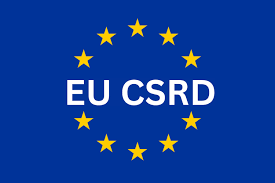
The EU’s Corporate Sustainability Reporting Directive (CSRD) represents a significant evolution in sustainability reporting, requiring thousands of companies across Europe (and those wanting to do business within the EU) to provide detailed disclosures on environmental, social, and governance (ESG) topics.
Some sustainability experts estimate that it will take more than six months or 900+ hours of time to complete a report in the required format for CSRD. This will of course vary on individual circumstances – but it presents an alarming statistic, particularly for time stretched businesses. Then there is the cost. Six months of a small team’s time is also expensive. Very expensive. This is one of the reasons Ripple exists after all and we believe we can make this process easier, less time consuming and more cost effective.
In this article, we give an overview on the main considerations for businesses who fall under the scope of the CSRD regulation.
The ‘what’ and ‘how’ of CSRD
The details and requirements for what to include in the sustainability management report are outlined in the European Sustainability Reporting Standards (ESRSs) which are the technical guidelines that companies must follow to meet CSRD requirements. If the CSRD is the “what” of sustainability reporting, the ESRS is the “how.”
Businesses falling under the full reporting scope are required to comply with the CSRD standards for the first time by publishing reports in 2025 covering reporting year 2024.
It is worth noting that a company’s reporting boundary has expanded to include the entire value chain in measuring and reporting social and environmental impact. This covers all participants, both upstream and downstream.
Who is affected by the CSRD?
The CSRD applies to large companies that meet two of the following three criteria:
- Net turnover of more than €50 million.
- Balance sheet assets greater than €25 million.
- More than 250 employees.
It also includes non-EU firms generating more than €150M in revenue within the EU, as well as listed small and medium-sized enterprises (SMEs). While non-listed SMEs are not currently mandated to report, they are increasingly being asked for related information and the European Commission has published voluntary standards tailored to their needs to support this.
Key dates and steps for compliance
The CSRD will be phased in over several years, starting in 2024. From 2026, listed SMEs will be required to comply although they can defer for 2 years if they choose. From 2028, non-EU companies with substantial activity in the EU (will have to comply and report in 2029. To prepare, companies should begin by building the necessary data infrastructure, governance frameworks, and internal controls for sustainability reporting.
ESRS: The How of CSRD compliance
The ESRS outlines specific metrics and topics businesses need to disclose, including issues like climate change, social matters, and governance structures. Companies must report using these standards to ensure their sustainability data is comparable and comprehensive.
How CSRD and ESRS work together
Both CSRD and ESRS aim to improve the quality and transparency of sustainability reporting, helping investors, stakeholders, and regulators assess companies’ sustainability performance more accurately. CSRD is the overarching directive, while ESRS provides the granular reporting standards.
To comply with CSRD, companies must adhere to the ESRS guidelines when preparing their reports.
Differences between CSRD and ESRS
CSRD is a legal directive outlining who must report and the broader reporting principles, whilst ESRS is a technical framework that provides detailed reporting metrics and formats for companies to follow.
Double Materiality: The root of CSRD reporting
CSRD introduces double materiality as a cornerstone of sustainability reporting. This concept requires companies to assess materiality from two perspectives:
- Impact Materiality – How the company’s activities affect the environment and society, such as emissions or social equity.
- Financial Materiality – How sustainability issues could impact the company’s financial performance, through risks or opportunities.
Double materiality is unique because it broadens the scope of reporting beyond traditional financial considerations, ensuring that businesses account for their societal and environmental impacts.
Double Materiality Assessment process
In a CSRD-aligned double materiality assessment, businesses should:
- Understand their sustainability context: Analyze their business model, strategy, and legal landscape.
- Identify sustainability impacts: Determine the positive and negative effects on people and the environment.
- Assess financial risks and opportunities: Evaluate how sustainability issues could influence the company’s financial health.
- Establish material topics: Determine which topics are relevant by setting qualitative and quantitative thresholds.
By conducting this assessment, businesses can identify material sustainability topics from both the impact and financial perspectives, ensuring they address all relevant areas in their CSRD-aligned reports.
Why ESRS matters for Double Materiality
Double materiality depends on identifying and reporting both impact and financial material topics. ESRS helps guide companies through this by providing specific standards to measure both impact and financial outcomes. While companies can report using ESRS, failing to demonstrate double materiality or meet all CSRD requirements could result in non-compliance.
For example, even with ESRS, if a company does not adequately assess the financial risks related to sustainability or lacks proper external assurance, it may fall short of CSRD requirements.
Key takeaways
Double materiality is central to CSRD, and companies must assess both their impact on society and financial risks. ESRS provides the detailed guidelines for companies to report in line with CSRD. Companies need to ensure alignment with all CSRD aspects, not just ESRS, to remain fully compliant.
Ripple simplifies the CSRD process and saves you time
Conducting a double materiality assessment is complex and time consuming. Ripple’s AI will automate most of the process and will create a report based on your data in minutes. You can customise the report and share with your relevant stakeholders and/or use the report to guide your corporate disclosure.
Ripple’s AI will also create a CSRD report aligned to the relevant guidelines for SMEs, Listed SMEs.
Book a demo now to see how Ripple can help save you time and costs with your CSRD reporting requirements.
